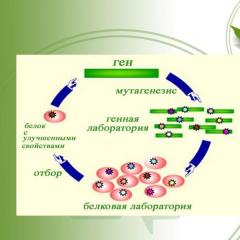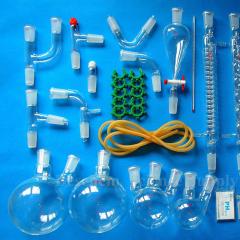R-S dissociations. Properties of bacteria. Non-heritable changes in the properties of bacteria. S - colonies. R - colonies. M - colonies. D - colonies of bacteria Colonies s shape
Principles of rational antibiotic therapy.
Principles of rational antibiotic therapy
Microbiological principle. Antibiotics should only be used as indicated when
the disease is caused by microorganisms against which there are effective
drugs. To select them, it is necessary to take material from the patient before prescribing treatment.
research, highlighting
pour a pure culture of the pathogen and determine its sensitivity to antibiotics.
Antibiotic sensitivity, or antibiogram, is determined using methods
dilution and diffusion (these include the paper disc method). Breeding methods
are more sensitive: with their help they find out which antibiotic is effective for
relation to a given microorganism, and determine its required quantity.
minimum inhibitory concentration (MIC).
Pharmacological principle. When prescribing an antibiotic, it is necessary to determine the correct
dosage of the drug, required intervals between administration of the drug,
duration of antibiotic therapy, methods of administration. You should know pharmacokinetics
drug, the possibility of combining various drugs.
Typically, infectious diseases are treated with a single antibiotic.
(monoantibiotic therapy). For diseases with a long course (subacute septic
endocarditis, tuberculosis, etc.) to prevent the formation of antibiotic resistance
combined anti-
biotic therapy.
Clinical principle. When prescribing antibiotics, the general condition of the patient is taken into account,
age, gender, immune system status, concomitant diseases, presence
pregnancy.
Epidemiological principle. When selecting an antibiotic, you need to know which
microorganisms in the environment surrounding the patient are resistant to antibiotics (department, hospital,
geographical region). The prevalence of resistance to this antibiotic is not
remains constant, but changes depending on how widely used
antibiotic.
Pharmaceutical principle. Expiration date and storage conditions must be taken into account
of the drug, since its long-term and improper storage results in the formation of toxic
degradation products.
Variation in bacteria may not be inheritable ( modification) and genotypic ( mutations, recombinations). Non-hereditary (environmental, modification) variability is due to the influence of intra- and
extracellular factors on the manifestation of the genotype. When eliminating the factor that caused
modification, these changes disappear.
Temporary, hereditarily not fixed changes that arise as adaptive reactions of bacteria to environmental changes are called modifications(more often - morphological and biochemical modifications). Once the cause is eliminated, the bacteria revert to their original phenotype.
The standard manifestation of modification is the distribution of a homogeneous population into two or more two types - dissociation. An example is the nature of growth on nutrient media: S- (smooth) colonies, R- (rough) colonies, M- (mucoid, mucous) colonies, D- (dwarf) colonies. Dissociation usually proceeds in the direction of Sà R. Dissociation is accompanied by changes in the biochemical, morphological, antigenic and virulent properties of pathogens.
One form of mutation is dissociation (from Latin dissociatio. splitting).
the appearance in a population of microorganisms of individuals different from the original ones
microorganisms appearance and structure of colonies, the so-called S- and R-forms (from English,
smooth. smooth, rough. rough). S-shapes of colonies. round, moist, shiny
smooth surface, straight edges; R-forms form irregularly shaped colonies,
opaque, dry with jagged edges and an uneven rough surface.
The different appearance of colonies corresponds to a number of properties. More often S-shapes are more
virulent, cells have normal morphology, biochemically "more active, usually
are isolated in the acute period of the disease; in capsular species the capsules are well developed, in
motile species have flagella. Smooth (S) and rough (R) colonies are extreme
forms of dissociation, between which transitional forms can occur. Dissociation
is considered as a phenomenon of genetic nature associated with chromosomal mutations
genes that control the synthesis of lipopolysaccharides in the bacterial cell wall.
Dissociation is known in many species. It is usually detected in aging crops.
Dissociation also occurs in natural conditions (in pathogenic microorganisms in living
body). Most microorganisms have full properties when in the S-form,
however, there are exceptions: for Mycobacterium tuberculosis, anthrax bacilli and
The normal plague causative agent is the R-form of colonies.
Bacterial colonization – colonization of the area and formation of the microbial community.
In laboratory conditions, colonization is the growth of bacteria in the form of colonies (individual round formations on solid nutrient media (PPS).
Under natural conditions, bacterial growth occurs in the form of biofilms (growth on the surface of the EPS).
In terms of the speed of their reproduction, bacteria surpass all other organisms. Under favorable conditions, bacteria can divide every 20 minutes, forming huge colonies.
If there is a lack of nutrients, the growth of the bacterial colony stops. Many bacteria begin to form spores, which serve to preserve individuals, and not for reproduction. When forming a spore, the bacterium produces a very dense shell. The spores prevent the bacteria from drying out and can tolerate low or high temperatures. Spores can remain viable for hundreds of years.
49. Features of the structure and functions of bacterial biofilm
It is now recognized that most microorganisms in natural and artificial environments exist in the form of structured, surface-attached communities - biofilms.
Biofilm - microbial community characterized by cells that are attached to a surface or to each other, enclosed in a matrix of extracellular polymeric substances they synthesize
Stages of biofilm formation:
Reversible adhesion
Irreversible (receptor-mediated) adhesion (exopolysaccharides)
Biofilm maturation
expression of genes responsible for the synthesis of signaling molecules:
Gr(+) - acyl-homoserine lactones,
Gr(-) - short-chain peptides
Matrix composition: microorganism polysaccharides and acidic polysaccharides (mucin - produced by the macroorganism),
The phenomenon of interaction between bacteria is called “ quorum sensing or "quorum sense"
QS-bacterial language of communication
(biofilm formation, pathogenicity, antibiotic synthesis)
The production of exogenous pathogenicity factors by bacteria in biofilms occurs only when they reach a certain critical mass of bacterial cells sufficient to overcome the body’s defense mechanisms and successfully develop the infectious process.
The role of microbial biofilms in the occurrence and development of such common diseases as:
infections associated with vascular catheterization caused by Staphylococcus aureus and other gram-positive microorganisms
infections of heart valves and joint prostheses caused by staphylococci
periodontitis caused by a number of oral microorganisms
urinary tract infections caused by E. coli and other pathogens,
middle ear infections caused by, for example Haemophilus influenzae
Environmental benefits of biofilms
Facilitation of nutrient access and metabolic cooperation
Protection from negative environmental influences
Resistance to antibacterial agents
Resistance to antibacterial agents:
inactivation of antibiotics by extracellular polymers or enzymes,
slowing down metabolism and, accordingly, reducing the growth rate of microorganisms under conditions of limited nutrients in the biofilm, due to which the antibacterial drug diffuses from the biofilm faster than it has time to act on them,
expression of possible resistance genes
the emergence of persistent microorganisms in the biofilm under the influence of antibiotics
Strategies to overcome resistance and control biofilms:
prevention of primary infection of the implant,
minimizing the initial adhesion of microbial cells,
development of methods for the penetration of various biocides through the biofilm matrix in order to suppress the activity of biofilm-associated cells
matrix destruction
A peculiar form of variability is the R-S dissociation of bacteria. It occurs spontaneously due to the formation of two forms of bacterial cells, which differ from each other in the nature of the colonies they form on a solid nutrient medium. One type - R-ko lonii (English rough - uneven) - characterized by uneven edges and a rough surface, second type - S-colonies(English smooth - smooth) - has a round shape, smooth surface. The process of dissociation, i.e. splitting of bacterial cells that form both types of colonies, usually flows in one direction: from S- to R-shape, sometimes through intermediate stages of the formation of mucous colonies. The reverse transition from R- to S-form is observed less frequently. Most virulent bacteria are characterized by growth in the form of S-form colonies. The exceptions are Mycobacterium tuberculosis, Yersinia plague, anthrax bacteria and some others that grow in the R-form.
During the process of dissociation, along with a change in the morphology of the colonies, the biochemical, antigenic, pathogenic properties of bacteria and their resistance to physical and chemical environmental factors change.
Mutations that lead to S-R dissociation are classified as insertional, since they arise after the integration of extrachromosomal factors of heredity, including temperate phages, into the bacterial chromosome. If this mutation leads to the loss of genes that control the formation of determinant polysaccharide units of LPS in gram-negative bacteria, then R-mutants are formed. They form rough colonies, change their antigenic properties and sharply reduce pathogenicity. In diphtheria bacteria, S-R dissociation is associated with their lysogenization by the corresponding bacteriophages. In this case, the R-forms form a toxin. In other bacteria, R forms arise after integration of R plasmids, transposons, or Is sequences into their chromosome. R-forms of pyogenic streptococci and a number of other bacteria are formed as a result of recombinations.
The biological significance of S-R dissociation is that bacteria acquire certain selective advantages that ensure their existence in the human body or in the external environment. These include higher resistance of S-forms to phagocytosis by macrophages and the bactericidal effect of blood serum. R-forms are more resistant to environmental factors. They are preserved for a longer time in water and milk.
At the same time, S-R dissociation in many cases complicates the bacteriological diagnosis of a number of infectious diseases, for example, Sonne's dysentery, escherichiosis caused by E. coli O124, etc.
The standard manifestation of modification is division of a homogeneous population into two or more types. The phenomenon was first studied by Veul and Felix (1917). At the suggestion of de Craif (1921), it was called dissociation of microbes. Typically, dissociations occur under conditions unfavorable for the original population (high ion concentration, suboptimal temperature, excessively alkaline environment), during culture aging (for example, during long-term storage) or under the influence of antiserum, bacteriophages and potent agents. Simple manifestations of dissociations available for observation are changes in the appearance and structure of bacterial colonies on solid nutrient media and growth characteristics in liquid media.
To designate dissociating colonies, Arkwright (1921) proposed the first letters of English names:
S-colonies[from English smooth, smooth],
R-colonies[from English rough, rough],
M-colonies[from English mucoid, slimy],
D-colonies[from English dwarf, dwarf].
Dissociation usually proceeds in the S -» R direction, sometimes through the formation of intermediate mucous (M) colonies. The reverse (R S) transition is observed much less frequently. Most bacteria pathogenic to humans form S colonies; The exception is the pathogens of tuberculosis, plague, anthrax and a few others.
It should be remembered that dissociations are accompanied by changes in the biochemical, morphological, antigenic and pathogenic properties of pathogens.
dissociation of bacteria
Phase VARIATION – splitting of a homogeneous population bacteria on options. From random mutations D. b. is characterized by a high frequency of occurrence and reversion of variants, amounting to 10 –2 – 10 –4 per cell division, as well as the constant nature of genetic changes, physiol. – biochem. and morphological properties. The best known is S-R dissociation, when, when reseeding crops on dense environments Instead of colonies of the smooth type (smooth) - S-forms - characteristic of the initial variant (phase I), rough colonies with an uneven edge (rough) - R-forms (phase II) are formed. Phenomenon D. b. must be taken into account during diagnostic studies, in microbiol. production.
Dissociation of bacteria
one of the forms of intrapopulation variability, consisting in the appearance in the population of individuals and clones that differ from the original type in the shape of the colonies and a number of other characteristics. The best known is S - R dissociation. Most eubacteria, when cultivated on solid media under optimal conditions and when isolated from bacteria, form round, shiny colonies with smooth edges and a smooth convex surface, called S-shape. In old breeds, when cultivated in unfavorable conditions, when isolated from the external environment and from convalescent patients, individuals appear in the population, which form larger, flatter colonies with an uneven edge and a rough matte surface, designated R-shape. Along with the shape of the colonies, S - R dissociation leads to changes in other characteristics, in particular agglutinability in broth, saline solutions, foreign substances, loss of capsule and motility, decrease in enzymatic activity, virulence, toxigenicity, antigenicity, immunogenicity , sensitivity to phages, physical. and chem. factors, increased phagocytability, etc. Changes in most characteristics are based on the loss or repression of the ability to synthesize lipopolysaccharide side chains of the bacterial cell wall . R-forms can sometimes revert to their original form. Phenomenon D. b. must be taken into account during diagnostic studies, in the production of bacterial preparations, microbiol. industry.
33. Recombination in bacteria: transformation, transduction, conjugation.
Recombination (exchange of genetic material) in bacteriadifferent from recombinations at eukaryotes :
Bacteria have several recombination mechanisms;
During recombination in bacteria, not a zygote is formed, as in eukaryotes, but merozygote(carries the entire genetic information of the recipient and part of the genetic information of the donor in the form of an addition);
In a recombinant bacterial cell, not only the quality changes, but also amount of genetic information.
Transformation- This exchange of genetic information in bacteria by introducing a finished DNA preparation into the recipient bacterial cell(specially prepared or directly isolated from the donor cell). Most often, the transfer of genetic information occurs when the recipient is cultivated on a nutrient medium containing donor DNA. To perceive donor DNA during transformation, the recipient cell must be in a certain physiological state (competence), which is achieved by special methods of processing the bacterial population.
During transformation, single (usually 1) characteristics are transmitted. Transformation is the most objective evidence of the connection of DNA or its fragments with a particular phenotypic trait, since a pure DNA preparation is introduced into the recipient cell.
Transduction- exchange of genetic information in bacteria by transferring it from donor to recipient using temperate (transducing) bacteriophages.
Transducing phages can transfer 1 or more genes (traits).
Transduction happens:
Specific - the same gene is always transferred;
Nonspecific - different genes are transmitted.
It's connected with localization of transducing phages in the donor genome:
In the case of specific transduction, they are always located in one place on the chromosome;
When nonspecific, their localization is inconsistent.
Conjugation- exchange of genetic information in bacteria by transferring it from donor to recipient during their direct contact. After the formation of a conjugation bridge between the donor and the recipient, one strand of donor DNA enters the recipient cell through it. The longer the contact, the more of the donor DNA can be transferred to the recipient.
Based on the interruption of conjugation at certain intervals, it is possible to determine the order of genes on the bacterial chromosome - construct chromosome maps of bacteria (produce mapping bacteria).
F+ cells have a donor function.
Important signs of colonies- their size and shape. Colonies can be large or small.
Size of colonies, colony sizes- a sign that allows you to distinguish between different species, genera and even types of bacteria. In most cases colonies Gram-positive bacteria are smaller than colonies of Gram-negative bacteria.
Colonies of bacteria can be flat, raised, convex, have a depressed or raised center (Fig. 11-15).
Another important sign is shape of colony edges(Fig. 11-16). When studying colony forms take into account the nature of its surface: matte, shiny, smooth or rough. Colonial edges can be smooth, wavy, lobed (deeply cut), jagged, eroded, fringed, etc.
Colony dissociations
Sizes and shapes of colonies may often change. Such changes are known as dissociation. Most often found S-dissociation And R-dissociation. S-colonies round, smooth and convex, with smooth edges and a shiny surface. R-colonies- irregular in shape, rough, with jagged edges.

Colony color
When viewing crops, pay attention to colony color. More often they are colorless, white, bluish, yellow or beige; less often - red, purple, green or black. Sometimes colonies become iridescent, that is, they shimmer with all the colors of the rainbow [from the Greek. iris, rainbow]. Coloring occurs as a result of the pigment-forming ability of bacteria. On special differentiating media, including special ingredients or dyes, colonies can acquire a variety of colors (black, blue, etc.) due to the inclusion of dyes or their restoration from a colorless form. In this case, their color is not associated with the formation of any pigments.



